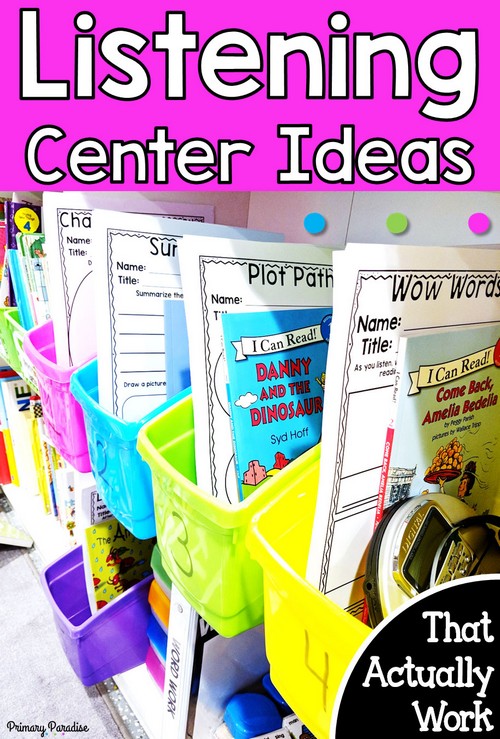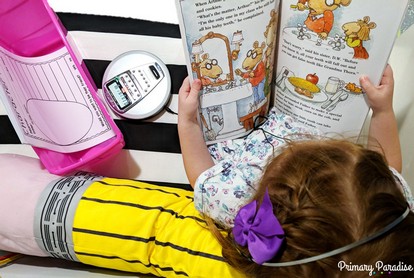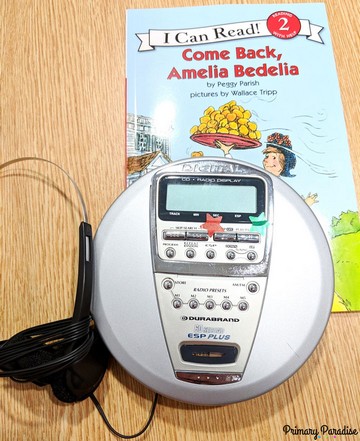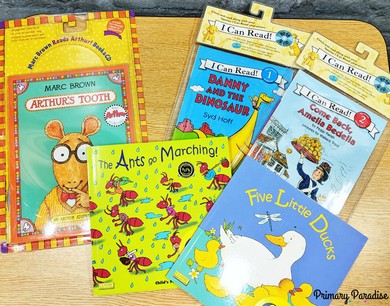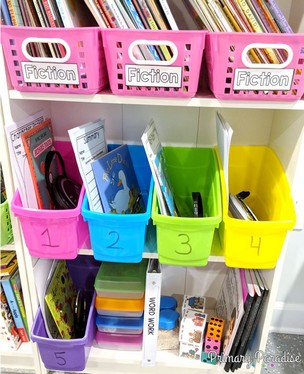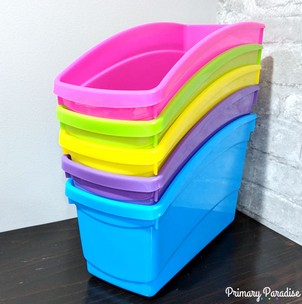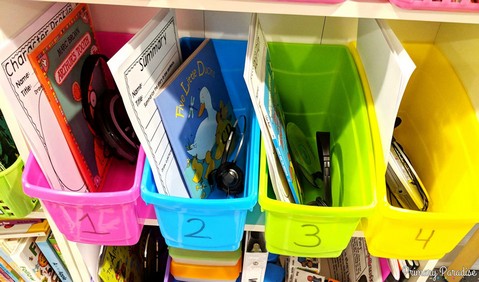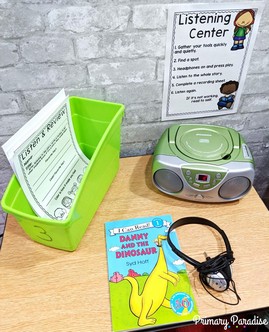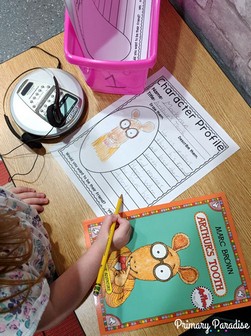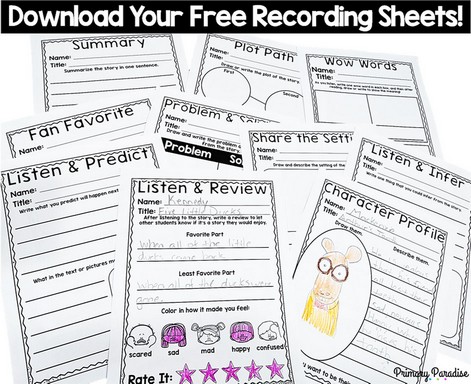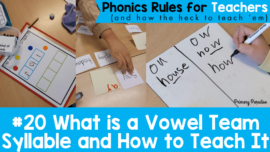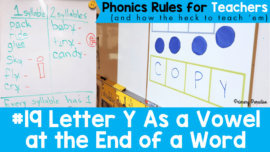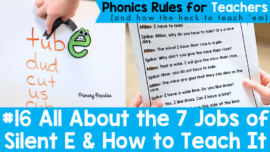Listening to reading: does it really matter? How can you set up listening centers for your students that allow your students to work independently, are simple to maintain, and are affordable? Today, I’m going to share some simple but highly effective ways to set up, organize, and maintain listening to reading centers in your classroom. I know that these ideas work because I’ve used them in my own classroom with my first and second grade students!
I want to thank Steps to Literacy for sponsoring this post. I received compensation for this post, but all opinions, ideas, and thoughts are mine.I only share about resources, products, and companies that I use and believe in and I believe will be beneficial to you as well!
Why Listening to Reading Is So Important
I’m often asked if listening to reading is really that important. If your students are reading to themselves and in partners and are working on words and writing, do they really NEED to listen to reading? The short answer? Absolutely! Here’s why.
Listening to fluent reading is so important for our students to develop reading fluency, expression, and comprehension skills.That’s why, as teachers, we always stress the importance of parents reading to their children. Listening to reading during ELA centers is equally important because it allows students to listen to a fluent reader while closely following along with the text. It can help with tracking text, and expression. It takes the pressure off of decoding, and allows students to focus on comprehension instead of getting stuck on words they don’t know.
In my mind, I think of listening to reading as learning to ride a bike with training wheels. It allows the reader to focus on the parts of reading that normally come after learning to decode. It allows students to feel successful, which builds confidence and leads to stronger readers who are willing to take risks such as trying to read more complicated texts on their own! Even students who are already master decoders and fluent readers can benefit from listening to the expression and dramatic reading. It also allows them to delve deeper into developing their comprehension skills. And lastly, it’s fun! If there’s something we can do for our students to help them enjoy reading, than, in my opinion, it is incredibly important.
Listening Centers: Everything You Need to Know
CD Players for Listening Centers
I’ve found using personal CD players to be the simplest and most cost effective way to build listening centers. Here are a few reasons why.
1. It’s important for students to have a book in their hand. There are a few websites that allow students to listen to reading, but they’re reading on a screen. Especially in primary grades, I think it’s really important for students to have a physical book in their hand.Using a book and CD player also takes away any possible distractions on the computer.You also don’t have to worry about Wi-Fi going down or blocked websites.
2. They’re super affordable… maybe even free! I’ve only ever purchased 2 CD players for my listening centers. The rest were free! Ask family and friends if they have any CD players laying around.Chances are a few people you know will have some that they’re not using. I’ve also found them very cheap at thrift stores and yard sales. Since most people don’t use them anymore, they’re often happy to get rid of them for free! If you do need to purchase some, you can often find a very basic portable CD player online between $10-$15.
3. They’re easy to use. Students really only need to know how to play, stop, and adjust the volume on the CD players. Put a green sticker on the play button, a red button on the stop button, and show students how to adjust the volume. That’s it! They’re set!
Where to Find High Quality Books on CD
In my first year of teaching, I wanted to set up a listening center, but I lacked the knowledge and resources, so I took some books I already had, an old cassette player, and attempted to record myself reading the stories. The result was… interesting. Oh, how I wish I knew about Steps for Literacy back then! If you’ve never heard of Steps to Literacy, they are an amazing, family founded company who truly care about the impact they have on schools, teachers, and students. Their mission is to partner with educators to ignite a passion for reading by providing accessible and exciting books that allow students to explore the work, cultures, and themselves! In partnering with them as I wrote this blog post, I’ve been blown away with their desire and passion to help educators and students.
Steps to Literacy Curation Specialists
Once of the most unique things about Steps to Literacy is their fantastic team of Curation Specialists. If you’re wondering what a Curation Specialist is, they’re basically your new best friend! Curation Specialists are all former educators who have professional experience in the field and have a passion for reading. They use their knowledge, experience, and expertise to create libraries and custom book bundles based on curriculum, reading levels, genre, standards, and dozens of other customizable options. If you are interested in having the Curation Specialists build a library for your classroom or school, you can simple fill out this short, simple form and they’ll reach out to you shortly.
Building a Listening Library with Steps to Literacy
Steps to Literacy is a fantastic resource for curating any part of your classroom library, but I am particularly in love with their read along book and CD sets. They have a variety of classic and newer titles, single books, and sets all for a very affordable cost! While perusing the website, some favorite titles that jumped out at me were Biscuit, Amelia Bedelia, Clifford, Frog and Toad, Henry and Mudge, Curious George,Fancy Nancy, and many popular fairy tales and folk tales! I also love that the guided reading levels are listed right on the website. This makes selecting a range of texts very simple!
The Curation Specialists hand selected a variety of titles for me, and I’m in love with each of them!
Author’s Tooth (which is read BY Marc Brown!), The Ants Go Marching, Danny and the Dinosaur, Come Back, Amelia Bedelia, and Five Little Ducks.
Listening Center Organization
Now that you have your read along books from Steps to Literacy and your CD players, let’s talk about set up! As always, my motto is keep it simple! How many actual listening centers you have will depend on the size of your class. It will also depend on the number of books and materials you have available. In the past, I’ve typically had three centers available for classes with 20-25 students. If you have materials to have more, that’s fantastic! However, don’t let a lack of materials hold you back from launching listening centers. Even if you only have 1 or 2 listening centers available now, that’s okay. Start with what you have and build your supply of materials over time.
Listening Center Storage
My goal is always to set up my classroom so students can work independently, so I store my listening centers in these sturdy, colorful bins from Steps for Literacy. I love them because they’re large enough to fit all of my students’ listening to reading supplies as well as large picture books. These bins don’t tip over like other bins. They’re also extremely sturdy and strong, and, of course, I love that they come in bright colors! They also stack neatly for easy storage over the summer.
What’s in the Listening Center Bins
I keep the listening to reading procedure simple. Students simply choose a bin, find a spot, and start reading with their CD! Each bin includes the book and CD player with the CD already in the player. It also holds headphones and a recording sheet to complete after they finish listening to the book. If I don’t have enough personal CD players, the bin will include headphones only. Students know that that means they need to go to one of the big CD player listen stations. They sit down, plug their headphones in, and then listen to their book.
Book Selection
I often hear that part of the struggle with listening to reading is that students take forever to select books. Students might also leave the books in disarray.This is why I’ve always selected the books for each bin myself. My students can pick the book bin they want, but they don’t ever change out the books. I also put the CDs in the CD player ahead of time. This means students simply take their bin, find a spot, and press play! They still get the change to choose from the books I’ve already picked, but it limits their choices so they spend more time reading. I change out the listening books every 2-3 weeks. I don’t have enough books that we never repeat, but that’s okay! It never hurts to listen to a book again.
Troubleshooting Listening Center Issues
As with all centers, the key to success is modeling and practicing appropriate behaviors. Do this until students know exactly what to do. There are always times throughout the year when students need to be reminded what our listening center expectations are. However, I’ve found taking a nice chunk of time in the beginning of the year and setting up simple routines prevents many issues. Additionally, displaying expectations is super helpful as well. I also recommend discussing what to do if there are issues before they happen so student are prepare.
Here are some common issues and how students can handle them so they didn’t need to interrupt small group.
1. Tangled headphones– I taught my 2nd graders to wrap the cord around the headphones neatly, but, of course there were times they got tangled. If they could still put them on, they just left the tangle and let me know when center time was over. If they couldn’t, they could try to untangle them for 1-2 minutes. At that point, if they still couldn’t, they just read to self.
2. Can’t hear anything– I taught my students how to adjust the volume. However, if they still couldn’t hear anything and adjusting the volume wasn’t working, they would read to self.
3. Dead batteries– I tried to check the CD player batteries every few days, but if they ran out, students simply read to self.
4. Finished early– If students listened to the book, completed their recording sheet, and there was still time left, they could listen again. If they’ve already listen again, they can grab their read to self bin and read to self!
Accountability
Teachers often tell me that students aren’t following along with the book. This is why I include recording sheets in each bin. Students know that they are expected to complete a recording sheet after they finish listening. They also knew that I would check it. I include duplicates of the same recording sheet in each bin. I would restock or change them out at the end of each week for the next week. This allows me to differentiate with a different recording sheet focusing on different skills in each bin. It also allows me to reuse books while focusing on different skills! If students completed a problem and solution recording sheet for Arthur’s Tooth a few months ago, that’s fine. I can still reuse that book and use a character profile recording sheet this time.
You can download these 10 recording sheets and the listening center rules sign by clicking the picture above.
If you are looking to start or refresh a listening to reading center in your classroom, I highly recommend visiting Steps to Literacy and using the suggestions in this post to get started! Your students will thank you!
Want to see more of my favorite resources from Steps to Literacy? Check out the posts below.
Diverse Chapter Books Rich Mentor Texts NGSS Science Book Collections Back to School Favorites White Board Tips Tactile Letters Christmas Crafts Small Group Organization STEM Tools Brain Breaks Calm Down Kit Ideas
You can join my FREE Facebook Club for k-2 teachers here!
AND BE SURE TO SIGN UP FOR MY NEWSLETTER FOR MORE TIPS, TRICKS, IDEAS AND FREEBIES!
Find me on Instagram, Facebook, Twitter, and Pinterest!
